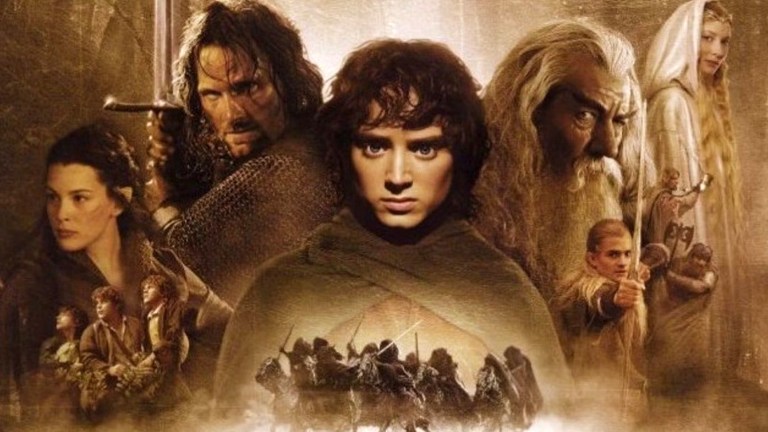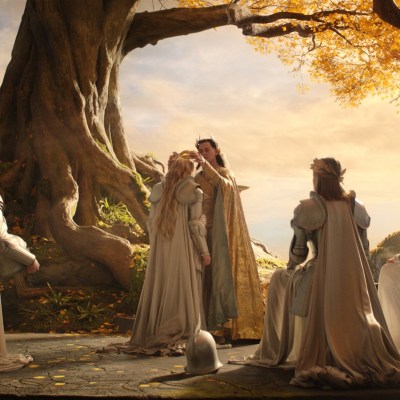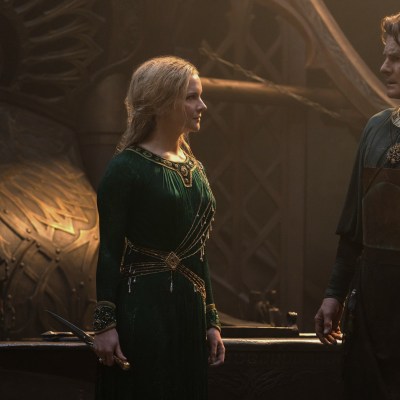Would J.R.R. Tolkien Have Wanted a Lord of the Rings Movie and TV Universe?
Warner Bros. is planning to make new Lord of the Rings movies, including spinoffs for some of our favorite trilogy characters. Would Tolkien have approved?

More and more screen adaptations of the works of JRR Tolkien are in development these days. In addition to Amazon’s The Rings of Power, a prequel series set during the Second Age of Tolkien’s Middle-earth, Warner Bros. Discovery announced in February that new films are also in development. The first will be an animated movie called The War of the Rohirrim, set 183 years before The Lord of the Rings and telling the story of a legendary king of Rohan called Helm Hammerhand, owner of the great horn at Helm’s Deep, which was named after him. We can only speculate on what else WBD might have planned — the love story of Aragorn and Arwen, told in the Appendices to The Lord of the Rings, is surely ripe for a film adaptation and would probably be our first choice.
A blockbuster Tolkien franchise incorporating various different stories and characters across different time periods and told in various media, like Star Trek, Star Wars, or the MCU, now seems very plausible. Announcements about the new films have even confirmed that the writers of the 2001-2003 films — Peter Jackson, Fran Walsh, and Philippa Boyens — have all been consulted, as the three put out a joint statement reported by Variety, saying they have been kept “in the loop every step of the way.” Amazon’s Rings of Power, in which Jackson, Walsh, and Boyens have not been involved, nevertheless makes frequent references to the films, from the first episode’s prologue, to the sweeping shots of New Zealand, to the costuming and character design. All the screen adaptations are clearly designed to link to each other, creating an unofficial “Tolkien Cinematic Universe,” if you will. But while Marvel fans have largely embraced the MCU, Tolkien fans are far more skeptical.
Some fans are both weary and wary of the ever-growing number of adaptations, which are increasingly distanced from the main story of The Lord of the Rings. Tolkien’s own son, occasional typist, and literary executor, Christopher Tolkien, who passed away in 2020, would not relish the current explosion of screen adaptations based on his father’s works. In 2012, Christopher Tolkien told Le Monde that, in his opinion, the Peter Jackson films had “eviscerated the book” to make “an action film for 15-26 year olds,” and that the films did not capture the beauty or seriousness of his father’s work.
However, JRR Tolkien and his son were not the same person, and there is no guarantee that all of their opinions would have aligned. In fact, Tolkien’s own attitude towards films based on The Lord of the Rings within his lifetime was fairly pragmatic. He had clear views on what he did not want. He intensely disliked Walt Disney Studios, so he would have been glad they are not involved. In 1957, American agent Forrest J. Ackerman approached Tolkien via his publishers about a proposed animated film adaptation of The Lord of the Rings. Tolkien replied, “I should welcome the idea of an animated motion picture, with all the risk of vulgarization… I think I should find vulgarization less painful than the sillification achieved by the BBC” (referring to a lost 1950s radio adaptation, not the acclaimed 1980s radio drama starring Ian Holm).
Tolkien wrote later that Ackerman had shown him some “astonishingly good pictures (Rackham rather than Disney)” of a proposed animated film. (Arthur Rackham was an English artist famous for his illustrations of fairies and fairy tales.) Tolkien had more issues with the proposed synopsis, including an objection to Lothlórien being depicted as a “fairy castle” and the fact that “people gallop about on Eagles at the least provocation,” but overall, he was not against the concept. He thought “an abridgement [of the story] by selection with some good picture-work would be pleasant… I am quite prepared to play ball, if they are open to advice.” He and his publisher Stanley Unwin had agreed on a policy of “Art or Cash. Either very profitable terms indeed; or absolute author’s veto on objectionable features or alterations.” Not on any alteration whatsoever – but just on alterations that Tolkien felt did not represent the spirit of his work.
Once he received the screenplay, Tolkien was disappointed by his impression that the writer had “skimmed through the L. R. at a great pace” and based his screenplay on “partly confused memories” without referring back to the original. Tolkien noted that Boromir had been misspelled as Borimor and that Radagast had become, inexplicably, an Eagle. He felt that the writer, Morton Grady Zimmerman, had shown a “complete lack of respect” for the book because the screenplay seemed “willfully wrong without discernible technical reasons.” Tolkien fans are absolutely correct that the author would not have liked any adaptation that did not appear to respect his works. But we can also see that Tolkien did not object to changes that were made for “technical” reasons — such as cutting down certain events in the story — to adapt the book for a new medium, as long as they were done with respect.
In 1958, Tolkien wrote a detailed letter on the Zimmerman script, listing his numerous complaints. In fact, he objected to several changes that eventually showed up in the Peter Jackson movies, which may be why Christopher Tolkien disliked them so much. Tolkien did not want Aragorn to “whip out a sword” in Bree because he was carrying the Sword That Was Broken, he insisted that the Black Riders should not scream but approach silently, there was no fight at Weathertop, and he did not see why the timescale of the story needed to be compressed. We will never know whether Peter Jackson could have done a better job than Forrest Ackerman did of explaining why he felt that these changes were, indeed, technical necessities.
But Tolkien wasn’t opposed to all changes. As an alternative to having the Eagles appear and carry the Fellowship to the Misty Mountains, he suggested cutting the snowstorm and Warg attack all together. He even suggested cutting what we usually call the Battle of Helm’s Deep – which Tolkien pointed out is actually “the defense of the Hornburg,” because Helm’s Deep is technically the ravine behind it. It was more important to him to keep the Ents’ story if they could not fit everything in, and the climactic Battle of the Pelennor Fields “would gain by having no competitor.”
What really mattered to Tolkien were the ethics of the story. He did not approve of the cutting of the temptation of Galadriel, noting that “practically everything having moral import has vanished from the synopsis.” He also said he would resent changes to the characters “even more than the spoiling of plot and scenery.” Whether any individual screen representation made after Tolkien’s death changes the morals or characterization too much is a matter of opinion, but we can at least see that those were the aspects he cared about the most.
Tolkien was writing about an adaptation of The Lord of the Rings specifically. Although the legal rights both Amazon and Warner Bros Discovery currently hold are both for adaptations of The Lord of the Rings material (on television for Amazon, on film for WBD), neither studio is currently producing a new dramatization of the actual trilogy. Instead, they are taking the bare bones of a history from the Appendices and creating essentially new stories based on them. Embracer Group, the Swedish media holding company which owns the worldwide film rights to The Lord of the Rings and The Hobbit, has also alluded to potential movie spinoffs following different characters from the books, namedropping Gandalf, Aragorn, Gollum, Galadriel, and Eowyn specifically.
One of the most frequent criticisms of Amazon’s Rings of Power from Tolkien fans has been that it is not an adaptation of Tolkien’s work, but essentially “fan fiction” inspired by Tolkien. And there is some truth to that label. The Appendices to The Lord of the Rings offer a very brief timeline of events covering thousands of years. The basic outline of events comes from Tolkien, but most of the writing on the show is the work of the showrunners and writers.
Tolkien objected strongly to the idea of sequels to The Lord of the Rings written by fans, having been sent requests from fans wanting to do so at least twice, something he described as an “impertinent contribution to my troubles.” It is likely, then, that he would not have been very enthusiastic about adaptations telling entirely new stories set in Middle-earth. But the current screen adaptations are not quite that, either. The central shape of The Rings of Power follows the history of Middle-earth described in Tolkien’s books. That is a different thing from wanting to write a sequel made up completely of new characters and storylines.
We know that Tolkien wanted to create a new mythology for England, and if that was indeed the case, it is quite possible he might have welcomed the development of fleshed-out versions of stories he had told only briefly. In 1951, Tolkien told his publisher Milton Waldman that he felt that England was lacking a mythology of its own. The myths and legends of the British Isles, including those of King Arthur, were Celtic, not English, while Germanic and Scandinavian myths were also lacking in “Englishness” because they weren’t connected to the geographical landscape of England. “Once upon a time,” Tolkien told Waldman, “I had a mind to make a body of more or less connected legend… which I could dedicate simply to: to England; to my country”.
If Tolkien really wanted to create a “body of legend,” then he would have appreciated that true myth and legend comes in many differing versions. There is no one, correct version of a myth or legend, no “original” text that must be adhered to come what may. There is the general shape of a story, and many different retellings of that story from different authors. In the Greek myth of the Trojan War, for example, there is a core event – the wife of Menelaus of Sparta ending up in Troy with the Trojan prince Paris – that can be represented in vastly different ways in different versions of the story. Sometimes Helen goes willingly, sometimes she is taken against her will. In some versions, Paris takes a copy of Helen to Troy and Helen herself spends the entire 10-year war in Egypt. No single version is right or wrong – they are all just different.
When it comes to the mythology of Middle-earth, Tolkien was constantly changing things himself. Of his Middle-earth legends, the only major works published in his lifetime were The Hobbit and The Lord of the Rings. He worked on The Silmarillion from 1914 until his death in 1973; a few weeks before he died he was still thinking about the details of Galadriel’s personal history and of Elvish child-bearing. It was in a state of constant flux, as can be clearly seen from the many drafts published in Christopher Tolkien’s phenomenal collection of his father’s unpublished writings and writing process, the 12-volume History of Middle-earth. Tolkien even changed The Hobbit years after it was published in order to fit in better with The Lord of the Rings (Gollum originally gave Bilbo the One Ring voluntarily when he lost the riddle game).
Tolkien’s feelings also changed over time – not surprising for someone who lived to the age of 81. In a letter to his son Michael written towards the end of his life (in 1970), he told Michael that he was still struggling with trying to get The Silmarillion ready for publication. It was difficult to “coordinate” aspects of The Silmarillion with The Lord of the Rings, and he told Michael that “’Stories’ still sprout in my mind from names; but it is a very difficult and complex task.” He said he “should like to put some of this stuff into readable form, and some sketched for others to make use of.”
He does not specify what he meant by that last part. Quite possibly what he had in mind was the work later done by Christopher, pulling together the various drafts in different written forms and editing it. But it is not impossible that he might actually have welcomed others coming to flesh out his stories after his death. After all, there may be a difference between how an author feels about people fiddling with their work while they are alive, and how they feel about the possibility of it happening after they have died.
Although a self-confessed pedant, Tolkien felt that the tone and character of the work was the most important thing. “Myth,” Tolkien told Waldman, “must, as all art, contain… elements of moral and religious truth (or error).” If anyone were to produce a story set in Middle-earth that offended Tolkien morally, he would surely be utterly horrified. He was, for example, vehemently anti-Nazi; when the German publishers of The Hobbit wrote in 1938 wanting to know about Tolkien’s ethnicity, he was appalled. He was not interested in complying with what he referred to in a note to his British publishers as “their lunatic laws” and said he would be happy to “let a German translation go hang.” Any story set in Middle-earth that espoused, for example, neo-Nazi values would, therefore, have Tolkien rolling in his grave if not jumping right out of it in protest. Thankfully, none of the major screen adaptations currently in production come under that heading.
It’s also worth noting that as well as considering Arthurian legend too Celtic to be English, Tolkien thought it was too “fantastical, incoherent, and repetitive.” There is certainly a risk that the more stories set in Tolkien’s world are written and produced, by different writers working for different companies, the greater the risk of the mythos becoming “incoherent,” as well as “repetitive.” But that is, once again, a subjective opinion.
So many of the arguments around what Tolkien might have thought about screen adaptations come down to individual views of a work of art. Anyone who finds a particular adaptation “incoherent,” or who feels that it has made changes as a result of ignorance and a lack of respect, rather than for practical reasons, will justifiably believe that Tolkien would not have liked it. However, another viewer could watch the same film or television show and think that it was not incoherent at all, and that any changes it made were included for sensible reasons, and therefore that Tolkien would have liked it. And they would be equally justified in that view, and there is no way to prove which, if either, is “correct.”
Ultimately, none of us can know what an author who died 50 years ago would think of something. Anyone who claims they know what Tolkien would have thought is lying. While it is possible he would have been horrified by the prospect of a Lord of the Rings cinematic universe, people taking up his stories and expanding on them in new media is the best evidence that he has succeeded in creating a new mythology, because to endure, a myth has to be retold.
All of the J.R.R. Tolkien quotes included here are taken from The Letters of JRR Tolkien, edited by Humphrey Carpenter, published by HarperCollins.


